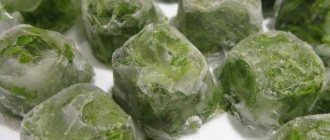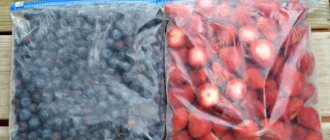Pomegranate is a large red fruit with a unique internal structure: under a thick peel there is an average of 600 seeds covered with bright red pulp. The seeds are grouped into segments that are separated from each other by a thin white film. The taste of the grains depends on the variety and degree of ripeness of the fruit: from sugary-sweet to sweet-sour with a hint of astringency.
The grains contain essential amino acids, vitamins B and C, and minerals: potassium, magnesium, iodine, iron. A decoction of the dried inner white membrane is used as a mild sedative, and the peel is used for cosmetic purposes. To fully appreciate the benefits of pomegranate, it is important not only to choose a ripe fruit, but also to store the pomegranate correctly.
The article provides recommendations for choosing a ripe and tasty fruit, and discusses the basic rules and shelf life of pomegranate in various conditions.
Selection of ripe fruits
When purchasing a pomegranate, pay attention to the following parameters:
- Weight. Ripe fruits are quite weighty - this indicates that there are no voids inside.
- Peel: color and texture. Pay special attention to the color of the peel; depending on the variety, it varies from soft pink to rich burgundy. However, the color of ripe specimens is always uniform and even. The rind is thin and slightly rough to the touch; a glossy surface indicates that the fruits were harvested ahead of time.
- General appearance. Inspect the pomegranate for signs of mold. Pay attention to the dark spots, they indicate that the fruit has begun to rot. The tasty pomegranate has a dense structure.
- Condition of the tail . The “crown” crowning the ripe fruit is always dry and fully open.
How to store pomegranate at home
If the necessary conditions are met, the pomegranate will be stored for a long time. To do this, ensure moderate humidity and a temperature of +1°C. Damaged fruits should not be stored, as well as overripe or broken ones. The duration will depend on the storage temperature. The pomegranate variety plays an important role, since sour varieties last a little longer than sweet ones.
- Frozen fruit will keep for a year.
- If the temperature is maintained at +1°C, the pods will be stored for 9 months.
- If the temperature is maintained at 4-6°C, storage lasts for only a few months. This temperature regime is typical for refrigerators.
- After a week, the pomegranate will be completely dry if you store it in a room where the temperature is 18-24°C.
Even at home, you can provide the fetuses with comfortable conditions. It will be cool on the balcony or in a dry cellar.
- If storage is to be on the balcony, then each fruit should be wrapped in a clean sheet of paper. The fruits are folded in one layer, and covered with a thin cloth or cardboard on top of it. In this way, it is possible to prevent exposure of the fruit to sunlight. Thus, the fruits will remain fresh and juicy for 5 months.
- When using a refrigerator, storage is carried out in special compartments used for vegetables and fruits. To retain sufficient moisture, use parchment paper. It is not recommended to use plastic bags. Spoiled fruits are eaten first and stored separately from whole pomegranates. They will keep in the refrigerator for several months.
Storing pomegranates at room temperature
A properly made mash, which is applied to the top of the fruit, can help in storing fruits. However, only selected fruits can be stored in this way. Any damage, dents, scratches and changes in color will not give the desired result. The fruits must be completely ripe. To prepare a clay mash you will need clay and warm water. The material is diluted to the state of homemade sour cream.
The fruits are dipped into the resulting mixture several times and left until the composition dries completely. The second layer is applied only after a day. The manipulations are repeated until the fruit is completely covered with clay. Afterwards, the fruits are placed in a box, which is installed in a dry place. Thus, you can extend the life of the fruit by 5 months.
Storing vegetables and fruits in clay using carrots as an example
Recommendations:
- Peeled fruit will last in the refrigerator for no more than 4 days.
- If you plan to store fruits on the balcony, then each fruit is wrapped in clean paper. The grenades are laid in one layer, on top of which a thin cloth is placed.
- The boxes should not be exposed to sunlight.
- Fruit is inspected regularly and spoiled fruit is removed.
Even if the harvest was incredibly bountiful, you should not despair and try to freeze everything, because this will require a lot of free space, which may not be available. A basement or semi-basement can be found in every home, just like a loggia. Peeled fruit grains can be stored in the freezer, while whole and ripe fruits can be stored in a cool place.
Using Clay
If you don’t have a basement or free space in the refrigerator, you can pour a clay-based solution over the fruit. This method is old and has already been proven many times. Thus, any fruit with a thick peel can be stored for a long time. Thus, fruits can be stored both in a humid and warm room without the risk of losing the harvest. You can also store it in a wooden box, which is placed on a glazed balcony. Fruits for storage are carefully inspected before the upcoming manipulations begin. The crown of the fruit should be dry and intact.
Sequencing:
- To disinfect, white clay is calcined in the oven.
- Warm water is used to dilute clay. The result should be a thick mixture.
- The fruits are dipped one at a time in the prepared mixture, after which they are set aside for a day for the clay to dry completely.
- A day later, the manipulations are repeated until the fruit is completely covered with clay.
- The crown is poured last.
Storing pomegranate in the freezer
Fruits such as pomegranates tolerate complete freezing well. The fruits do not lose their consistency or taste. You can freeze both pomegranate seeds and the whole fruit. For freezing, fruits that cannot be stored under any other conditions are used. Often we are talking about fruits that are overripe or slightly deformed during transportation. The pomegranates are wiped with a dry paper towel and then placed in special containers. Preference should be given to containers in which air can be removed.
Overripe fruits are stored in grains. It is also recommended to keep fruits in grains that cannot be preserved in other conditions:
- scratched;
- wrinkled;
- cracked;
- small.
The partitions are carefully removed, the grains are washed, dried and placed in dry and clean storage containers. This way the fruit will last for a year. Subject to simple conditions and requirements regarding transportation and storage of these southern and juicy fruits, you can safely buy them in boxes and not be afraid of bountiful harvests.
Storing pomegranate in the cellar
The ideal option for storing juicy pomegranate fruits is a cellar or any other basement.
Compliance with a certain temperature regime is mandatory. Cardboard boxes are used for storage. All fruits are pre-wrapped in paper so that the fruits do not give up all the moisture and juice. For greater confidence in maintaining a bountiful harvest, it is recommended to dip the fruit in a solution based on white clay. However, regardless of the thickness of the applied clay layer and the quality of the fruit itself, they should be stored in one row, avoiding direct sunlight and contact of pomegranates. After some time, all fruits are inspected for spoilage. Fruits that cannot be called ideal should be removed from the total mass. Damage can also be caused by a small blow caused during transportation. Such defects will appear only after some time.
Storing pomegranate on the balcony
Storage on the balcony requires compliance with certain conditions that will help keep fruit fresh for several months. Storage methods are selected independently:
- Partial covering with clay can also be used to store pomegranate fruits on a warm balcony. To do this, do not cover the entire fruit. It is enough to dip the top (crown) of the fruit several times. Afterwards, the fruits are covered with thin and always natural fabric. If the microclimate in the room is optimal, then they will be stored for up to six months.
- Fruits can be wrapped in special (waxed) or regular paper. After which the grenades are placed on shelves in the closet. It is not recommended to apply multiple layers. The layer is covered with a thin breathable fabric that will absorb moisture. Thus, the fruits are stored for two months.
The first option allows you to preserve the integrity of not only ripe, but also overripe fruits. They will not ripen during storage.
How to store pomegranate at home
5 (100%) 2 votes
How to store a whole pomegranate
After purchasing ripe fruits, you should think about their further storage. Where to store pomegranates so they don't spoil? The correct choice of method will preserve most of the beneficial properties. Keep pomegranates at room temperature, in the refrigerator or freezer.
Room conditions
To preserve pomegranate at home, observe the following conditions:
- room temperature +18…+24°C;
- humidity level 60%;
- a dark place where direct sunlight does not reach;
- a craft paper bag; it is not recommended to store fruits in plastic;
- Shelf life: no more than 7 days.
Fridge
What is the best way to preserve pomegranate at home? A refrigerator is the best option.
Temperature affects shelf life:
- at a temperature of +4...+6°C, pomegranate is suitable for consumption for several months;
- at a temperature of about +1°C the period increases to 9 months;
Do not store fruits in plastic bags, use paper ones - the fruits will not dry out in them.
The refrigerator compartment is best suited for storing fruits and vegetables, since temperature changes at this level are minimal.
Balcony or cellar
In the cold season, the fruits are placed in a cellar or on a glazed balcony.
For both options, storage standards are the same:
- temperature about +5°C;
- each fruit is individually wrapped in paper;
- wrapped specimens are laid out in a single layer on the bottom of a cardboard box with holes for ventilation or a wooden box;
- to avoid direct sunlight, cover the grenades with a sheet of cardboard or loose fabric;
- Shelf life: about five months.
To reduce the evaporation of moisture from the fruit, the tail of the fruit is filled with clay mixed with water, after which the mixture is allowed to dry on the top and the berry is placed in a dark and cool place.
This is interesting:
Storing potatoes at home during the winter - how to do it correctly.
Storing butter in the freezer - conditions and terms.
Freezer
For longer storage, deep freezing is used, but in the freezer, after some time, the fruit loses some of its beneficial properties. Pomegranate can be frozen whole or in the form of grains. In both cases, the shelf life reaches one year.
Freezing the whole fruit
To freeze the whole fruit, follow these rules:
- temperature –18°C;
- choose fresh, dense fruits without signs of mold and rotting;
- the fruits are placed in plastic containers and tightly covered with lids;
- place containers with the product in the freezer, observing the proximity of the product (do not place it near meat and fish products).
Freezing grains
Freezing rules:
- temperature –18°C;
- choose fresh, dense fruits without signs of mold and rotting;
- Do not wash pomegranate kernels before freezing;
- put the kernels into portioned bags to defrost not the whole mass, but the required amount;
- place the container with the product in the freezer, observing the product proximity;
- Avoid re-freezing the product.
How to store
To prevent pomegranates from spoiling, they must be stored at a temperature of +1...+10 °C and moderate humidity. If the latter is high, the fruit will quickly rot, and if it is low, it will dry out. A basement or cellar or refrigerator is suitable for storage.
In the apartment
At room temperature +18...+24 °C, in relative warmth, it will not be possible to preserve pomegranates for a long time, a maximum of 7 - 10 days. Afterwards they will begin to dry.
Cut or peeled pomegranate is best consumed within 2 to 3 days. Store in the refrigerator for the entire period; at room temperature, the product will lose its properties in the first day.
In a refrigerator
In the absence of high humidity, pomegranates should be stored in the vegetable compartment of the refrigerator. In a cool, dry place, the fruit will last for 1 - 2 months.
Each fruit must be wrapped loosely in clean paper (not newspaper) or parchment. And once a week, inspect the fruits, removing spoiled ones, and replace the damp paper with new ones.
In the cellar or basement
In such storage, the temperature should also not rise above +10 °C.
Option 1. In boxes
Wrap the selected fruits in clean paper or parchment. Place them in a box in 1 - 2 layers, pre-cover the bottom with paper. Cover the top with thick cardboard or cloth. This way the fruits are stored without losing their quality for up to 2 months.
If the temperature conditions are observed, without changes, the box can also be kept on an insulated balcony.
Option 2. In a clay shell
Prepare a clay mash by mixing water with clay until it becomes liquid sour cream. Dip each pomegranate with a “crown” into the pulp, let it dry and place it in a row on racks (in a cardboard box or wooden box), and cover the top with a cloth. If the clay crust has not set, there are gaps, the procedure can be repeated.
In this kind of “cocoon” they can lie for up to 5–6 months. It is believed that unripe pomegranates can ripen with this storage method.
In a clay “wrapper” you can also preserve carrots or watermelons for a long time for the winter.
How to properly peel a pomegranate
There are many ways to clean a pomegranate. This is due to the complexity of the structure of the fruit: under the thick and durable skin there are thin and fragile nucleoli, which, if handled carelessly, quickly burst and stain everything around.
Note. Pomegranate juice has a strong coloring effect. Leaves hard-to-remove bright marks not only when it gets on clothes, but also on the skin of your hands.
Method for cleaning pomegranate:
- A well-washed pomegranate is placed on a cutting board.
- Using a knife, cut off the base of the fruit and cut it into 4 parts.
- The resulting quarters are placed in a container filled with water.
- Separate the grains from the peel with your hands.
- The film and white dense “partitions” inside the fruit are removed.
- After complete cleansing, wash the grains with clean water.
The advantage of this method is that it minimizes the amount of juice flowing to the surface. Since pomegranate kernels are heavy, when cleaned in water they sink to the bottom of the container, and the lighter parts (film and porous crust) float to the top. This allows you to quickly separate the edible parts from the “garbage”.
How to choose pomegranates for long-term storage?
Not all fruits are suitable for home storage. In order not to worry about the quality of the products, when buying fruit you should pay attention to the following points:
- The appearance of the fruit plays an important role. It’s good if the peel is pinkish or red, without dents, cracks or stains. Any deviations from the norm indicate the beginning of a putrefactive process.
- A ripe fruit is covered with a skin, through which the grains are clearly visible or palpable. The peel should be dry and similar to very thin tree bark. If there is moisture, the workpieces will have to be dried first.
Tip: Pomegranate peel is no less useful than its juice. In addition to a set of substances necessary for the human body, it contains components that can get rid of worms. The bark just needs to be brewed in boiling water and can be used as a treatment or prevention for a number of problems.
- You can press lightly on the fruit, the ripe grains will crunch slightly.
- A tasty and ripe pomegranate cannot be easy. Lack of weight indicates that the grains have already begun to dry out and there is little juice in them. But if a product is unusually heavy for its size, this indicates its high quality.
If the pomegranate has a stalk, it should not be green, but dried out, framed by dry sepals. The presence of wet or rotten elements is unacceptable.
Where is the best place to store grenades?
It is best to store pomegranates in winter in a cool, dry place. This is the fundamental principle by which you need to choose the optimal place for the “wintering” of fruits.
Where to store unpeeled pomegranate
Clean, dry boxes are suitable as containers for storing fruit in natural conditions (cellar, insulated loggia). It is better to cover the bottom with paper so that the moisture that may appear on the fruit in small quantities has somewhere to be absorbed. Additional measures can be taken. Wrap each fruit in a clean piece of paper. This way there will be no chance for moisture to persist, accumulate and give rise to the process of rotting.
The bottom of the box must be covered with paper.
Where to store peeled pomegranate
In addition to the refrigerator compartment, you can also use the freezer compartment. When deep frozen, fruit can be stored for more than a year. In this way it is good to store those fruits that could not be preserved in other ways. For example, one fruit is rotten. It needs to be peeled, sorted, damaged areas removed and placed in a container (bag) for freezing.
How to store pomegranate on the balcony?
If it is possible to provide the above conditions on the balcony, storage of pomegranates can be organized in one of the following ways:
- We wrap each fruit in plain or wax paper and put it in boxes. They should not be high, a maximum of two layers is allowed, otherwise the fruits will burst. It is recommended to additionally line the containers with fabric that absorbs moisture well and cover them with material that does not transmit light. The shelf life of such products is about two months.
- Claying can be used to store pomegranates, but not completely, but partially. From clay and water we prepare a composition with the consistency of liquid sour cream. We lower the top part of the pomegranate (the part where the crown is) into it and leave it to dry. We put the fruits prepared in this way on shelves and cover them with a thin cloth. If the room is dry enough, the products can stay there for up to 5 months.
The second approach can be used to store not only ripe, but also slightly unripe pomegranates. They will slowly reach the desired state, which will further increase their shelf life.
How to store pomegranates at room temperature
Thanks to the clay mash, you can store pomegranate in your apartment. This method is only suitable for selected fruit. The pomegranate must be free of scratches, dents, damage in any way and absolutely ripe.
The clay mash needs to be prepared in this way: you need to take white clay and pierce it in the oven. Next, dilute in warm water. The consistency should be similar to thick sour cream. The fruits need to be dipped into this mixture and wait until it hardens completely.
A day later, you need to repeat the same thing. The result should be as follows: the fruit should be completely covered in a clay shell. Then the fruits will need to be put in boxes and put in a dry place. In this way, pomegranate can be stored for up to five months.











